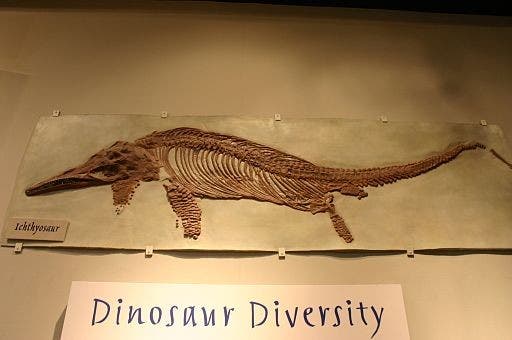An ancient ichthyosaur fossil was recently unearthed in Scotland. Ichthyosaurs are extinct reptiles which ruled the seas during much of the Mesozoic era.

The fossilized remains of 170 million year old ichthyosaur has finally been made available for display after being stored for more than 50 years.
(Photo : Ryan Somma (Ichthyosaur Uploaded by FunkMonk)/Wikimedia Commons)
While dinosaurs roamed the earth, ichthyosaurs were the kings of the seas. Based on fossil evidence, they first appeared approximately 250 million years ago and at least one species survived until about 90 million years ago. They grew up to sixteen meters in length and had many features that resembled both modern fish and dolphins.
However, while there are plenty of ichthyosaur fossils, this one comes from a period when such fossils are particularly rare – 170 million years ago.
“The Middle Jurassic is one of the most poorly known times in the history of dinosaurs and in the history of other reptiles like ichthyosaurs,” says University of Edinburgh’s Steve Brusatte, part of the team examining the fossil. The “spectacular” find, he says, “has a lot of potential.”
It took two generations for the fossil to receive proper appreciation. The fossil, dubbed as Storr Lochs Monster, was first discovered in 1966 by an amateur paleontologist called Norrie Gillies while he was having a stroll near the Storr Lochs power station in Edinburgh. Realizing what he’d found, he sent a letter to the Royal Scottish Museum and a team was sent to investigate the fossil.
But after the fossil was transferred to the museum, it was simply left in its concrete case and locked somewhere in storage and all but forgotten – as it too often happens. Fast forward a few decades and Allan Gillies, son of Norrie Gillies and an engineer at the power station where the fossil was found, contacted Stephen Brusatte, a professor at University of Edinburg and one of the lead researchers analyzing the fossil.
“Dad’s not around to see it himself, but I know he’d be very, very pleased to know that it’s finally being displayed, and he’d also be very pleased to know that it’s the company he worked for that helped to make it happen,” Allan told National Geographic. “It’s sort of completing the story.”
Dad found the fossil, and his son helped with the fundraising for the fossil analysis. Ultimately, working together from over time, the two made it happen – the ichthyosaur fossil was removed from its concrete casing and is up for display in the museum. It’s a testament that anyone can make a difference in science if they’re truly passionate about it.
Paleontologists still don’t know what species it is, but they’re slowly unveiling its mysteries.
“This new ichthyosaur can and, I’m sure, will tell us a good few things about ichthyosaur paleobiology, and marine reptiles more generally,” says Benjamin Moon of Britain’s University of Bristol. Very little fossil material is known from that time period, he says, so this new specimen will help fill a gap.









